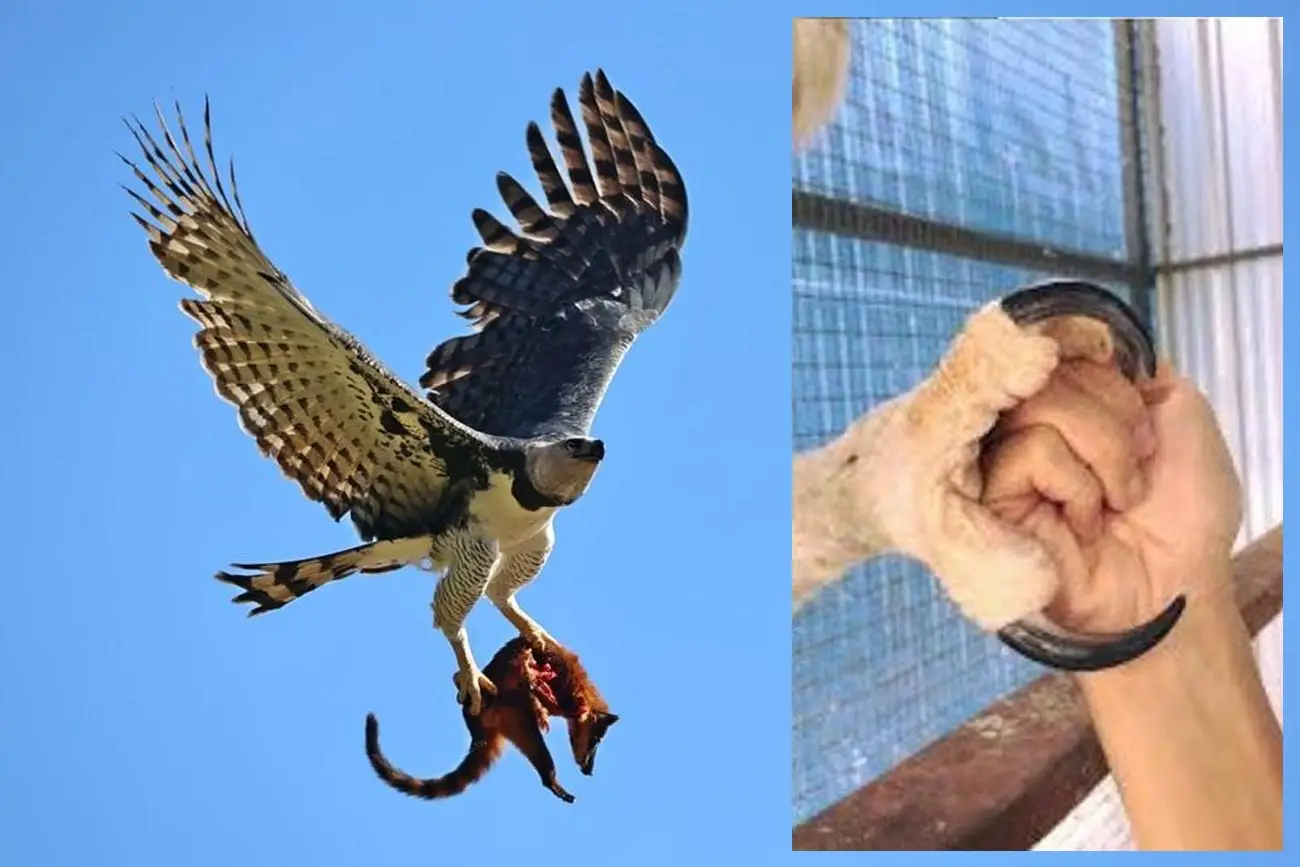What is the Harpy Eagle?
The Harpy Eagle, also known as harpy, is a bird of prey found in tropical forests of Central and South America, especially in the Brazilian Amazon. With a wingspan that can exceed 2 meters, it's a true colossus of the skies. Moreover, its majestic stature and piercing eyes make it a symbol of respect and admiration among indigenous peoples and environmentalists.
Despite its common name, the Harpy Eagle isn't technically a "hawk." It belongs to the Accipitridae family, being more closely related to eagles. Its scientific name, Harpia harpyja, was inspired by the harpies of Greek mythology - winged creatures with a fierce appearance, which couldn't be more appropriate.
Surprising facts about this bird
The Harpy Eagle is shrouded in mysteries and fascinating facts. Here are some that will leave you amazed:
- It has the largest talons of any bird in the world. Its claws can measure up to 13 cm - larger than a grizzly bear's!
- Can carry prey weighing up to 7 kg in flight, including sloths, monkeys, and other medium-sized animals.
- Has extremely sharp vision, being able to spot prey from over 200 meters away even in dense forests.
- Forms monogamous pairs for life, building enormous nests atop centuries-old trees.
- Can live up to 35 years in the wild, though this lifespan is shorter in areas with high deforestation rates.
These characteristics make the Harpy Eagle not only an imposing bird but also essential for the balance of the forests it inhabits.
Why is the Harpy Eagle so special?
Unlike other birds of prey, the Harpy Eagle plays a fundamental ecological role. It's at the top of the food chain and helps maintain population balance for various species like monkeys and rodents. This prevents ecological imbalance and contributes to the health of tropical forests.
Additionally, the harpy is a natural indicator of environmental quality. Where there are Harpy Eagles, there is preserved forest. Therefore, protecting them means protecting thousands of other plant and animal species that depend on the same ecosystem.
Unfortunately, due to habitat loss, illegal hunting, and rampant deforestation, this majestic bird is threatened with extinction in many areas. In fact, it has already disappeared from many Brazilian states where it was once common, such as São Paulo and Espírito Santo.
Where can the Harpy Eagle be found?
Currently, the Harpy Eagle is found in some regions of Central America (like Panama and Costa Rica) and in various South American countries, such as Venezuela, Colombia, Peru, Ecuador, Bolivia, and of course, Brazil.
Within Brazilian territory, its presence is concentrated especially in the Legal Amazon, including states like Amazonas, Pará, Amapá, Acre, and Rondônia. Although there are sporadic sightings in Atlantic Forest areas, its occurrence in these regions is increasingly rare.
Besides the harpy, there are other impressive birds of prey worldwide, such as:
- Golden Eagle (Aquila chrysaetos) – Europe, North America, and Asia
- Philippine Eagle (Pithecophaga jefferyi) – Philippines (one of the world's largest)
- Crested Eagle (Morphnus guianensis) – South America (the harpy's cousin)
- Crowned Eagle (Stephanoaetus coronatus) – Sub-Saharan Africa
However, none combine as much strength, beauty, and ecological importance as our Harpy Eagle.
Is it possible to keep Harpy Eagles in captivity?
This is a frequent question among bird lovers: can Harpy Eagles be domesticated? The answer is straightforward: no. The Harpy Eagle is a wild animal protected by environmental laws. Keeping it as a pet is prohibited by Brazilian and international legislation.
However, there are environmental institutions and research centers that keep specimens in controlled captivity for conservation, assisted reproduction, and environmental education purposes. Examples include the National Institute of Amazonian Research (INPA) and the Harpy project, maintained in partnership with the Chico Mendes Institute (ICMBio).
It's important to remember that even in these environments, the Harpy Eagle needs ample space, specialized veterinary care, balanced nutrition, and constant physical and mental stimulation. Therefore, it's an animal that should never be kept as an exotic pet under any circumstances.

Conservation challenges and how to help
The Harpy Eagle faces many survival challenges, primarily habitat destructionhabitat destruction. Amazon deforestation and agricultural expansion are drastically reducing areas where this bird can live and reproduce.
Other concerning factors include:
- Illegal hunting, whether due to fear, ignorance, or wildlife trafficking.
- Low reproductive rate, with intervals of two to three years between broods.
- Lack of specific public policies for the species in many regions of the country.
However, there is hope. Several projects are engaged in protecting the species, such as the aforementioned Harpy Project, along with work by NGOs like WWF-Brazil, Blue Macaw Institute, and SOS Amazônia.
You can also make a difference:
- Avoid consuming products linked to deforestation.
- Support reputable conservation institutions through donations or volunteering.
- Share information about the Harpy Eagle, helping to raise collective awareness.
- Educate friends and family about the importance of wild birds.
The union between civil society, public authorities, and science is crucial to save the Harpy Eagle from extinction.
Tips for bird and nature lovers
If you're fascinated by birds like the Harpy Eagle and want to get closer to the world of ornithology and environmental preservation, here are some practical suggestions:
- Invest in birdwatching: a hobby combining nature, adventure, and learning.
- Join guided hikes in nature reserves and parks.
- Create feeders and water stations for native birds at home or in your yard - but never feed wild birds processed food!
- Follow conservation profiles and channels to keep learning.
- Talk to children about biodiversity, planting seeds of awareness early.
Loving nature also means respecting each species' limits and understanding that the Harpy Eagle's place is in the forest, free and sovereign.
The forest king needs us!
The Harpy Eagle is much more than just a gigantic and powerful bird. It's a symbol of resistance, strength, and environmental balance, and its presence in tropical forests is a clear sign that nature still pulses with vigor.
However, without our help, this giant risks disappearing silently. Therefore, valuing the Harpy Eagle means valuing the entire web of life that depends on forests.
Share this article with your friends, comment on what surprised you most, and explore more amazing content here at Adore Pets! Together, we can protect what's most beautiful and wild on our planet.
















Add comment